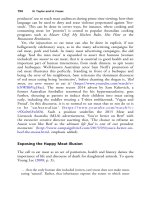The palgrave international handbook of a 488
Bạn đang xem bản rút gọn của tài liệu. Xem và tải ngay bản đầy đủ của tài liệu tại đây (27.45 KB, 1 trang )
490
R. Hediger
hard work of military life’ (2011, p. 291). Many of these deceased animals
became meat for the soldiers.
Camels saw similar experiences in many wars. In World War I, the
Palestinians campaigned against the Turks under the direction of General
Allenby, who employed 50,000 camels. ‘Less than half survived that final
year of World War I’ (Kistler 2011, p. 280). Similarly, when ‘the exiled
ruler of Ethiopia, Haile Selassie, led a large force from Sudan to retake
Ethiopia’, he used 15,000 camels, only 50 of which survived; ‘the rest
died in the forced march’ (Kistler 2011, p. 280). Modern war is rife with
animals suffering and dying at such massive scales.
Or consider the case of pigeons, often used as messengers in war, a
relationship that goes well back in time. In modern wars, pigeons remained
useful. Kistler reports, for instance, that ‘96 % of messages sent by pigeon
in World War I arrived in a timely fashion’ (2011, p. 248). In World War
II, the single year 1942 saw the British Royal Air Force use ‘nearly 500,000
pigeons’ (Kistler 2011, p. 251). Such vast involvement helped to inspire the
celebration of a particularly effective individual bird, Winkie, the pigeon
awarded the first Dickin Medal, a British prize that celebrates the acts of
animals in war (Kistler 2011). Wartime pigeon success, however, led to
countermeasures: ‘Nazis used trained hawks to kill pigeons’ (Kistler 2011,
p. 254), and ‘the British drafted peregrine falcons to catch and kill’ Nazi
pigeons (Kister 2011, p. 248). A more macabre recognition of pigeons’
effectiveness came in another episode, when the Germans invaded Belgium
in World War I. Kistler writes that ‘Commander Denuit, the head of the
Belgian Pigeon Service, could not allow the enemy to capture his 2,500
homing pigeons. With tears running down his face, he set fire to the base,
burning the birds alive’ (2011, p. 244). It was exactly their success that led
to their gruesome demise. In a situation parallel to the fate of U.S. war dogs
in Vietnam, who were first successful in their work and then abandoned as
an entire population, pigeons have seen their status radically reversed.
Kistler points out, ‘Since the end of pigeons in military service, the bird
species is viewed only as a bane to human societies, not a help’ (2011,
p. 258). They have thus become targets to extermination in a range of
places, from the U.S. to South Africa and beyond. Abuse in this case
typifies too much of the thinking connected to war, in which whole
populations of humans and animals become expendable, killable, a logic
that Lindseth describes as ‘exterminism’. He suggests ‘ecology’ as an alternative model, in which shared lives and interdependence receive emphasis, a
view congruent with the argument of this chapter (2013).









